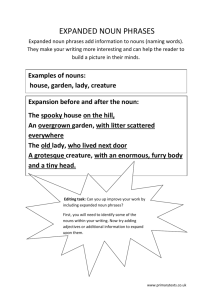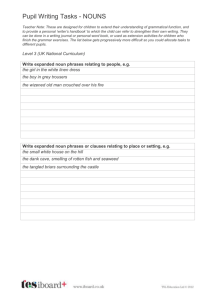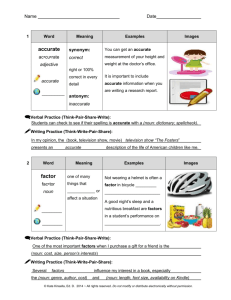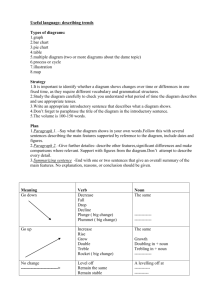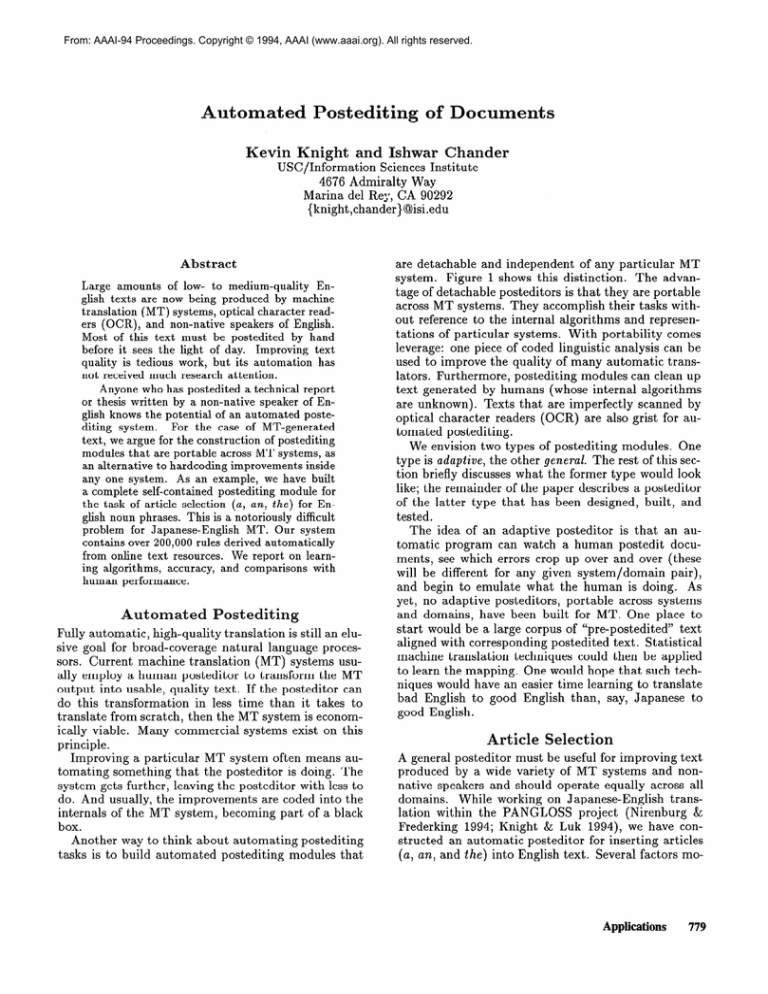
From: AAAI-94 Proceedings. Copyright © 1994, AAAI (www.aaai.org). All rights reserved.
Automated
Kevin
Postediting of Documents
Knight
and Ishwar Chander
USC/Information
Sciences Institute
4676 Admiralty Way
Marina de1 Rey, CA 90292
{knight ,chander}@isi.edu
Abstract
Large amounts of low- to medium-quality English texts are now being produced by machine
translation (MT) systems, optical character readers (OCR), and non-native speakers of English.
Most of this text must be postedited by hand
before it sees the light of day. Improving text
quality is tedious work, but its automation has
not received much research attention.
Anyone who has postedited a technical report
or thesis written by a non-native speaker of English knows the potential of an automated posteFor the case of MT-generated
diting system.
text, we argue for the construction of postediting
modules that are portable across MT systems, as
an alternative to hardcoding improvements inside
any one system. As an example, we have built
a complete self-contained postediting module for
the task of article selection (a, an, the) for English noun phrases. This is a notoriously difficult
problem for Japanese-English MT. Our system
contains over 200,000 rules derived automatically
from online text resources. We report on learning algorithms, accuracy, and comparisons with
human performance.
Automated
Postediting
Fully automatic, high-quality translation is still an elusive goal for broad-coverage
natural language processors. Current machine translation (MT) systems usually employ a human posteditor to transform the MT
output into usable, quality text. If the posteditor can
do this transformation
in less time than it takes to
translate from scratch, then the MT system is economically viable. Many commercial systems exist on this
principle.
Improving a particular MT system often means automating something that the posteditor is doing. The
system gets further, leaving the posteditor with less to
do. And usually, the improvements are coded into the
internals of the MT system, becoming part of a black
box.
Another way to think about automating postediting
tasks is to build automated postediting modules that
are detachable and independent of any particular MT
system. Figure 1 shows this distinction.
The advantage of detachable posteditors is that they are portable
across MT systems. They accomplish their tasks without reference to the internal algorithms and representations of particular systems. With portability comes
leverage: one piece of coded linguistic analysis can be
used to improve the quality of many automatic translators. Furthermore, postediting modules can clean up
text generated by humans (whose internal algorithms
are unknown). Texts that are imperfectly scanned by
optical character readers (OCR) are also grist for automated postediting.
We envision two types of postediting modules. One
type is adaptive, the other general. The rest of this section briefly discusses what the former type would look
like; the remainder of the paper describes a posteditor
of the latter type that has been designed, built, and
tested.
The idea of an adaptive posteditor is that an automatic program can watch a human postedit documents, see which errors crop up over and over (these
will be different for any given system/domain
pair),
and begin to emulate what the human is doing.
As
yet, no adaptive posteditors,
portable across systems
and domains, have been built for MT. One place to
start would be a large corpus of “pre-postedited”
text
aligned with corresponding postedited text. Statistical
machine translation techniques could then be applied
to learn the mapping. One would hope that such techniques would have an easier time learning to translate
bad English to good English than, say, Japanese to
good English.
Article
Selection
A general posteditor must be useful for improving text
produced by a wide variety of MT systems and nonnative speakers and should operate equally across all
domains.
While working on Japanese-English
translation within the PANGLOSS
project (Nirenburg &
Frederking 1994; Knight & Luk 1994), we have constructed an automatic posteditor for inserting articles
(a, an, and the) into English text. Several factors mo-
Applications
779
Japanese
Good
English
e
El
Japanese
PE
Better
English
Good
English
(b)
Figure 1: Two views of automating tasks of postediting.
In (a), posteditor work is automated and moved into a
particular MT system. In (b), a detached postediting module is created. It serves to improve the quality of text
produced by several MT systems and non-native speakers.
tivated this choice:
The Japanese language has no articles,
free English is difficult to read. ’
Inserting
articles is tedious
English-speaking
posteditor.
work
for
but articlea human
Non-native English speakers find accurate article selection very difficult, even after years of practice.
Doing the task well is beyond the capabilities
rent automatic grammar checkers.
Here is an example of the task.
comes in without articles:
The
of cur-
following
text
Stelco Inc. said it plans to shut down three
Toronto-area
plants, moving their fastener
operations
to leased facility in Brantford,
Ontario.
Company said fastener business
"has been
under severe cost pressures
for some time."
Fasteners,
nuts and bolts are sold to North
American auto market.
Company spokesman declined to estimate impact
He said new facility
of closures on earnings.
will employ 500 of existing 600 employees.
Steelmaker
employs about 16,000 people.
The posteditor
transforms
this text as follows:
Stelco Inc. said it plans to shut down three
Toronto-area
plants, moving their fastener
operations
to a leased facility
in Brantford,
Ontario.
The company said the fastener business
"has
780
Natural Language
Processing
been under severe cost pressures
for some time."
The fasteners, nuts and bolts are sold to the
North American auto market.
A company spokesman declined to estimate the
impact of the closures on earnings.
He said
the new facility will employ 500 of the
The steelmaker
employs
existing 600 employees.
about 16,000 people.
Accuracy on this task can be measured quantitatively.
As a first approximation,
we take newspaper-quality
English text, remove the articles, have our program
re-insert articles, and compare the resulting. text to
the original. When the two match (i.e., the program
has restored the original article), we score a success.
Otherwise, we score a failure. Dividing successes over
total articles in the text yields accuracy. Note that this
scoring method is a bit unforgiving: if either article is
permissible in a certain phrase, we still score a failure
for not matching the article chosen by the author of the
original text. We pay this price in order to get a fully
automatic evaluation set-up. Real accuracy figures will
be slightly higher than those reported.
We have made two simplifications
to the problem
of article selection for the purposes of the experiments
described in this paper. One is that we assume noun
phrases are already marked as singular or plural, as
Japanese has no such markings,
in normal English.
however, so it would be more realistic to build a posteditor to insert plural forms and articles simultaneously.
The system described here is more suited to RussianEnglish translation, since Russian has plurals but no
articles. The second assumption we make is that we
are given placeholders for the articles, and each decision is a binary one: the versus u/an.’ We are now
in the process of lifting these restrictions in order to
select plurals and other types of articles, especially the
zero article.
Performance
Bounds
What expectations
should we have about how well
a program might perform article selection?
We performed several experiments to answer this question.
Guessing by coin-flip (heads equals the, tails equals
u/an) yields an accuracy of 50%.
But we can improve our accuracy to about 67% simply by guessing the every time. We determined this by inspecting
40 megabytes of Wall Street Journal text, noting the
breakdown of articles as follows:
(???
“price”)
Performance was between 79% and SO%, thirteen
percentage points better than no-context performance
(always guess the) but fifteen percentage points worse
than full-context performance.
This gives us some idea
of local versus discourse effects in article selection.3
The final task used a slightly expanded
context.
Subjects were shown the core noun phrase plus two
words to the left of the unknown article and two words
to the right of the head noun, e.g.:
((“I,”
“said”)
(???
“reduced”
“dividend”)
(“reflects”
“the”) >
( (“losses”
“for”)
(???
“fiscal”
“year”)
(“ending”
“Ott”))
a a = 28.2%
e un = 4.670
o the = 67.2Y0
So 67% is a good lower bound on expected performance; we shouldn’t do worse.
To get some upper bounds, we tested two human
subjects on the following task: Given an English text
with articles replaced by blanks, try to restore the original articles.2 Subjects performed with accuracies between 94% and 96%. These numbers show that articles
contain very little information (in the Shannon sense),
because they are quite predictable from context. This
confirms our intuition that languages without articles
transmit information at no special handicap. But English articles are not completely predictable, and 95%
is a good upper bound on performance.
An analysis of
the 5% errors shows that some are cases where a and
the are synonymous in context, while others are cases
where the human subject failed to read the author’s
intent.
The human subjects were asked to perform two other
tasks.
In one, subjects had to predict articles in a
very limited context, namely, given just the head noun
following the article and its premodifiers.
Here is a
sample of this task:
(???
(???
(???
(???
(???
“reduced”
“dividend”)
“fiscal”
“year”)
“profit”)
“new” “dividend”
“rate”)
“pilot”
“training”
“school”)
‘Choosing between a and an is done as a final step.
We use a hand-built trie-driven algorithm detailed enough
to distinguish a unique guest from an unimpressed
guest.
Minor difficulties remain only with previously unseen
acronyms, e.g., distinguishing a NATO grant from an NIH
grant.
2This blank is an ambiguous “pseudo-word” in the sense
of (Gale, Church, & Yarowsky 1992), which we proceed to
disambiguate.
( (“last”
“had”)
(???
“profit”)
“1985”))
Pin”
( (“1985”
” . “>
(???
“new” “dividend”
“payable”))
(“is”
“rate”
( (“Academy”
“, “1
(???
“pilot”
“training”
( “based”
“at ‘I> >
>
“school”)
“disclose”)
( ("to"
(???
“price”)
( ‘I .” “Cornair”) >
Subjects achieved an accuracy of 83% to 88%. This
amount of context is what we showed our program
when we evaluated it, so these figures are good upper
bounds for its behavior.
To summarize the results of this section:
I human
I machine
1
random
always guess the
given core NP context
given NP plus 4 words
given full context
These numbers are not accurate to any degree of
statistical significance, due to the small survey size. It
was not our intention to make a full-blown psychological study of human article selection; rather, we wanted
to establish rough targets to tell us how far we have to
go and when to stop.
3Noun phrases were presented to human subjects in a
random order. Presenting them in original-text order would
allow the humans to make use of the same discourse effects
we are trying to screen out.
Applications
781
Algorithms
In thinking about the selection of articles a, an, and
the, natural starting points are the notions of definiteness and discourse.
Articles a and an introduce new
discourse entities, while the often signals back to previously mentioned or inferred entities. As the previous
section indicated, some of article selection requires full
discourse context, while some requires only local context. Usage rules are extensively covered in 100 pages
of the English grammar reference (Quirk & Greenbaum
1973). These include:
General knowledge:
Immediate
situation:
Indirect anaphora:
was faulty.
Sporadic
week.
Logical
reference:
uniqueness:
Body parts:
Generic
the Moon.
feed the cat.
he bought
a car, but the engine
she goes to the theater
every
they have the same hobby.
hit in the eye.
use: the/a
Referential,
the President,
tiger is a ferocious
Non-uniqueness:
Nonreferential,
Description:
beast.
a dog bit me.
she is a good player.
These rules (in spelled-out form) are proper analyses
of article selection, but they are difficult to operationalize, due to the representations
and world knowledge
required. Coding large amounts of general knowledge
with AI techniques is known to be hard. And even
fully armed with such knowledge, non-native speakers
still have trouble mastering the rules.4
The rules are generally easier to operationalize when
they are accompanied by examples and exceptions, the
more the better. Exceptions are common, as demonstrated by differences between British and American
article usage. This led us to leave the rules behind and
move to a purely data-driven approach.
We generated a database of over 400,000 core noun
phrases from Wall Street Journal text. This database
is the same one we used to test the human subjects:
4Notice also that most rules describe when to use the.
For Q and an, (Quirk & Greenbaum 1973) say: “The indefinite article is notionally the ‘unmarked’ article in the
sense that it is used (for singular count nouns) where the
conditions for the use of the do not obtain.”
Unfortunately, with the occurring 67% of the time, we
are in much more need of finding conditions for the use of
Q and an. To see this, consider a the rule that correctly
covers 25% of all noun phrases. The remaining 75% would
break down as follows: 56% the and 44% u/cm.
In the
absence of other rules, we might as well also guess the for
these noun phrases, yielding the same overall accuracy of
67%. On the other hand, an u/m rule covering 25% of all
noun phrases would leave 89% the and 11% u/an. Guessing
the for these would yield a total accuracy of 92%
782
Natural Language Processing
(("I,"
“said” >
("the"
"reduced"
"dividend")
("reflects"
"the"))
(("losses"
"for")
("the"
"fiscal"
"year")
(“ending”
"Ott"))
(("last"
('la"
(“in”
"had")
“profit
1’)
”1985”) >
( (I’1985” ” . “>
("The"
"new" "dividend"
“payable”))
("is"
"rate")
(("Academy"
",">
“training”
( "a" "pilot"
("based"
"at"))
“school”)
(("to"
"disclose")
("the"
“price”)
( II .” "Cornair"))
We then looked at which words, word features, and
combinations of these were most predictive of the given
article. The head noun is most critical.
If the head
noun is White House (this happened 238 times in the
database),
the article is almost always the (236/238
times). Plural head nouns, regardless of root, usually
have the. Premodifiers like next and same prefer the,
as do superlative adjective premodifiers, regardless of
root. Combinations
are critical: deficit as a head noun
is not very predictive, and neither is Federal as a premodifier, but combined, they have a strong preference.
If ago follows the head noun directly (this occurred 881
times), the article is never the. Words like triple are
influential just before the article, as in triple the cost.
Other frequent patterns include rest of the, clear the
way, X% a year, a sign of, etc.
This exploratory data analysis led us to develop a set
of binary features that characterize any noun phrase.
These features are either lexical (word before article
is ‘triple’) or abstract (word after head noun is a past
tense verb).
Lexical features were obtained directly
from the database. Any word appearing in a given position more than once counts as a feature.
Abstract
features include part-of-speech,
plural marking, tense,
and subcategory
(superlative
adjective,
mass noun,
etc.).
The problem now is to predict the article based on
the features of the context.
Given that the features
are not independent,
care must be taken to integrate
the “votes” each feature wants to make. We decided to
take a decision tree approach (Quinlan 1986; Breiman
et al. 1984) to modeling feature interaction.
To the decision tree builder, each feature f has three
statistics of interest. The first is frequency of occurrence pi, the second is the distribution
of the versus
a/an for noun phrases in which the feature is present
~2, and the third is the distribution
for those without the feature p3. Choosing a feature splits the data.
The goal is a roughly even split with the resulting
two data sets being more informative than the original. An information-theoretic
approach to choosing
the best feature is to pick feature f that minimizes:
-P1
* l%(Pz)
- (1 - Pl)
* l%(Ps)
The tree builder recurses on the data sets that result
from the feature-based
split. We terminate the recursion when the training examples are 98% in agreement
with one another.
Applying the tree to a new noun
phrase means walking down the tree, based on the
phrase’s features, returning the article stored at the
leaf node.
The main difficulty with learning is that we have
over 400,000 training examples and over 30,000 features. (The number of features is high because it includes lexical features such as word directly after head
noun is ‘ago’.) Choosing a feature for the root of the
decision tree would require, by the straightforward implementation,
400,000 . 30,000 operations to compute
~1, ~2, and p3 for each feature. To cut down on the
computation,
we throw out features with less than four
instances. We-also note that any given lexical feature
will have a small ~1, i.e., it will occur infrequently in
the database.
So we can compute a feature’s p3 by
closed form, given a distribution Q at the node:
p3=Q-PpleP2
1 -p1
We then index features with associated training
st antes for fast computation
of PI and ~2.
in-
t
I
I
I
I
I
I
0
142
284
426
568
710
852
I
I
994 1136
I
1278
Number of training instances
Figure 2: A learning curve for article selection.
The
graph shown is for noun phrases ending in president.
The curve shows test-set performance plotted against
training instances fed into the decision tree builder.
Data points are annotated with the size of the decision
tree built.
Results
Because the space of features and training examples
is still large, we decided to break the training data
into subsets.
We began with high-frequency
head
nouns.
For example, president occurs 1420 times in
our database. The breakdown of associated articles is
as follows:
e a/an
= 46.5Y0
e the = 53.5%
We trained a decision tree to generate articles for
president noun phrases based on the premodifiers, two
words before the article, and two words after. Training
on 90% of the data and testing on 10% yielded a tree of
171 questions and a test set accuracy of 89%. Figure 2
shows the learning curve for noun phrases ending with
president. We built ten decision trees, giving each tree
more training data than the last. The curve shows
test-set accuracy for each tree, along with tree size.
Performance
on noun phrases ending in year was
94%) and for stock 90%.
These good scores indicate that with enough training
data, we can generate highly accurate decision trees.
Unfortunately, of the 23,871 distinct head nouns found
in our training database, most occur only once or twice.
But-fortunately-the
3413 head nouns occurring at
least 25 times account for 84% of the instances.
At the time of this writing, we have built 1600 trees
for the 1600 most popular head nouns, covering 77% of
the test-set instances. On these instances, we achieve
8 1% accuracy, which approaches human performance.
For the remaining 23%, we simply guess the, for an
accuracy of 66%. The overall accuracy is 78%. We expect to improve this figure by several points by building more trees, adding more instances, and aggregating
many of the low-frequency head nouns on the basis of
shared features.
Related
Work
and
Definiteness/indefiniteness
of noun phrases has been
an object of linguistic study for a long time.
Computational linguists have been particularly
concerned
with finding referents for definite noun phrases (Grosz,
Joshi, & Weinstein 1983; Sidner 1983), an anaphora
problem with clear applications for text understanding.
Applications
783
Text generation research has tackled problems in generation of determiners from a semantic representation
(see, e.g., (Elhadad 1993) for a discussion of judgment
determiners).
Practical MT systems deal with article
selection when the source language does not have articles, but the target language does.
Our postediting algorithm achieves an accuracy rate
of 78% on financial texts without the benefit of a semantic representation to work from. It does not require
an analysis of the source language text, nor even that
such text exists. If such representations were available,
we could trade portability for increased accuracy.
In some sense, our results are another testament to
the power of “know-nothing”
statistics to achieve reasonable accuracy and broad coverage. But this is an
exaggeration, because our program has a great deal of
knowledge built into it. The biggest piece is the noun
phrase parser, which finds the most predictive element
of the context.
Often the head noun is far from the
article, and often other nouns intervene-for
these reasons, features like “noun x appears within 3 words to
the right of the article” are too imprecise.
Word classes also form an important piece of knowledge. Abstract features that characterize large numbers of training cases provide us with trustworthy
statistics. Lexical features occurring infrequently may
be important, but it is impossible to distinguish them
from noise. At present, we only use syntactic word
classes, but semantic classes (Miller 1990; Brown et al.
1992) could help to alleviate our sparse data problem.
Future Work
As noted earlier, we are now working to relax certain
assumptions
about the article selection task and our
evaluation.
We are extending our training database
and the zero
to include noun phrases with some/any
article. We will re-run our human experiments to get
new upper bounds and use the same training procedure (with binary features) but distributions over four
a/an, the, some/any,
and zero.
possible outcomes:
We do not intend to produce determiners this and
that, as these are explicitly marked in Japanese. The
new database is being built from part-of-speech-tagged
text; our current algorithms parse noun phrases anchored at a, an, and the without the need for tagging
software. We also plan to:
e Measure how performance
degrades on other types
Currently, we test the algorithm on text
of text.
drawn from the same population it was trained on.
e Incorporate
full-context
discourse features into the
model. Humans do about 15% better when the full
discourse is available.
With the right features, we
hope to capture some of this gain. What the right
features are, however, is still unclear.
o Turn to other routine
include plural selection,
punctuation.
784
postediting
preposition
Natural Language Processing
These
tasks.
selection, and
Acknowledgements
We would like to thank Eduard Hovy for his support
and for comments on a draft of this paper.
Thanks
also to Yolanda Gil for her comments. This work was
carried out under ARPA Order No. 8073, contract
MDA904-91-C-5224.
References
Breiman, L.; Friedman, J. H.; Olshen, R. A.; and
Stone, C. J. 1984. Classification and Regression Trees.
Wadsworth International Group.
Brown, P.; Pietra, V. D.; deSouza, P.; Lai, J .; and
Mercer, R. 1992. Class-based n-gram models of natLinguistics 18(4).
ural language. Computational
Elhadad, M. 1993. Generating argumentative judgment determiners. In Proceedings of the Eleventh National Conference
on Artificial Intelligence.
AAAI.
Gale, W.; Church, K. W.; and Yarowsky, D. 1992.
Work on statistical methods for word sense disambiguation. In AAAI Fall Symposium
on Probabilistic
Approaches to Natural Language.
Grosz, B. J.; Joshi, A. K.; and Weinstein, S. 1983.
Providing a unified account of definite noun phrases
in discourse. In Proceedings of the Zlst ACL, 44-50.
Knight, K., and Luk, S. K. 1994. Building a largescale knowledge base for machine translation.
In
AAAI-94.
Wordnet:
Miller, G.
1990.
database. International
Journal
(Special Issue).
An on-line lexical
of Lexicography 3(4).
Nirenburg, S., and Frederking, R.
1994.
multi-engine machine translation.
In ARPA
Language Technology Workshop.
Quinlan, J. R. 1986. Induction
chine Learning l( 1):81-106.
of decision
Toward
Human
trees. Ma-
1973.
A Concise
Quirk, R., and Greenbaum,
S.
Grammar of Contemporary
English. New York: Harcourt Brace Jovanovich.
Sidner, C. L. 1983. Focusing in the comprehension
of
definite anaphora. In Brady, M., and Berwick, R. C.,
eds., Computational
Models of Discourse. Cambridge,
Massachusetts:
The MIT Press. 267-330.

